| ﹛ |
|
|
Fishing Club
|
﹛ |
Fishing Tour
Saltwater Fishing in BC
|
|
Freshwater Fishing
by Location
.gif)
Abbotsford
Agassiz
-
Fraser - Hamilton Road
-
Fraser - Johnsons Slough Mouth Bar
-
Fraser - Limbert Road
-
Fraser - Maria Slough Bridge
-
Fraser - McDonald Road Bar
-
Fraser - Mountain Slough
-
Fraser - Sea Bird Island
-
Fraser - Wadsworth Island Bar
Beaverdell
-
Collier Lake -
Lower
-
Collier Lake -
Upper
-
Cup Lake (Beaverdell)
-
Lassie Lake
Boston Bar
-
Blue Lake
-
Hannah Lake -
East
-
Hannah Lake -
West
-
Nahatlatch Lake
每 East
-
Nahatlatch Lake
每 West
Chehalis - Upper River
-
Chehalis -
Logging Bridge
Chilliwack
-
Chadsey Lake
-
Chilliwack Lake
- North
-
Chilliwack Lake
- South
-
Cultus Lake
-
Flora Lake
-
Fraser -
Agassiz-Rosedale Bridge Bar
-
Fraser - Ballam
Road Bar
-
Fraser - Big
Eddy Bay West Shore
-
Fraser - Big
Fish Bar
-
Fraser - Camp
River Mouth
-
Fraser - Cheam
Slough Mouth Bar
-
Fraser -
Chilliwack Mountain Bar
-
Fraser - Ferry
Island Bar
-
Fraser -
Gallagher Bar
-
Fraser - Gill
Bar
-
Fraser -
Greyell Island
-
Fraser -
Harrison Hill Bar
-
Fraser - Island
22
-
Fraser - Island
Downstream of Ferry Island
-
Fraser -
Jesperson Bar
-
Fraser - Lower
Bowman Bar
-
Fraser - Lower
Island Bar
-
Fraser -
McGillivray Game Preserve
-
Fraser -
McGrath Bar
-
Fraser -
Morrows Bar
-
Fraser - Old
Orchard Bar
-
Fraser - Pegleg
Bar
-
Fraser - Upper
Bowman Bar
-
Fraser - Upper
Ferry Island
-
Fraser - Upper
Island Bar
-
Fraser -
Webster Bar
-
Fraser -
Wellington Bars
-
Greendrop Lake
-
Lindeman Lake
-
Pierce Lake
-
Vedder - River
Bar
-
Vedder - River
Mouth
Christian Valley
Enderby
Falkland
-
Pillar Lake -
North
-
Pillar Lake -
South
-
Pinaus Lake -
East
-
Pinaus Lake -
West
Grand Forks
-
Christina Lake
- English Point
-
Christina Lake
- North
-
Christina Lake
- South
-
Christina Lake
- Texas Point
-
Christina Lake
- Treadmill Creek
-
Wilgress Lake
-
Xenia Lake
Greenwood
Harrison Hot Springs
-
Deer Lake -
Harrison
-
Hicks Lake
-
Slollicum Lake
-
Stacey Lake
-
Trout Lake
Harrison Mills
-
Francis Lake
-
Fraser - Kilby
Provincial Park
-
Fraser - Queens
Island
-
Grace Lake
-
Harrison
Railway Bridge Bar
-
Harrison River
Bridge
-
Harrison River
Mouth Island Bars
-
Lake Errock
-
Lookout Lake
-
Morris Lake
-
Sunrise Lake
-
Weaver Lake
-
Wolf Lakes
-
Wood Lake
Hope
-
Devils Lake -
Hope
-
Fraser -
Chawathil Bar
-
Fraser -
Coquihalla River Mouth Bar
-
Fraser - Ferry
Landing Place
-
Fraser - Floods
Bar
-
Fraser - Haig
Scale Bar
-
Fraser - Lower
Bristol Island Bar
-
Fraser -
Pipeline Bar
-
Fraser - Rotary
Trails Bars
-
Fraser -
Silverhope Creek Bar
-
Fraser - Tom
Berry Bar
-
Fraser - Upper
Bristol Island Bar
-
Fraser - Wardle
Street Bar
-
Jones Lake
-
Kawkawa Lake
-
Lake Of The
Woods
-
Silver Lake
Kelowna
-
Arlington Lake
#1
-
Arlington Lake
#2
-
Arlington Lake
#3
-
Bouleau Lake
-
Idabel Lake
-
Okanagan Lake -
Fintry
-
Okanagan Lake -
Kelowna
-
Okanagan Lake -
Peachland
-
Okanagan Lake -
Penticton
-
Okanagan Lake -
Vernon
-
Okanagan Lake -
Westbank
-
Okanagan Lake -
Winfield
-
Rose Valley
Lake
-
State Lake
-
Taurus Lake
-
Thone Lake
-
Wilma Lake
-
Wood (Westwold)
Lake - North
-
Wood (Westwold)
Lake - South
Laidlaw
-
Fraser - Bulger
Road Bar
-
Fraser - Cheam
View Bar
-
Fraser - Cheam
View Hole
-
Fraser - Gold
Dredge Bar
-
Fraser - Hunter
Creek Bar
-
Fraser - Jones
Creek Bar
-
Fraser - St
Elmo Road Bar
Lumby
-
Greenbush Lake
-
Holstein Lake
-
Keefer Lake -
East
-
Keefer Lake -
West
-
Nevertouch Lake
Manning
-
Flash Lake
-
Lightning Lake
- North
-
Lightning Lake
- South
-
Nicomen Lake
-
Poland Lake
-
Thunder Lake
Merritt
-
Boss Lake
(Merritt)
-
Courtney Lake
-
Davis Lake
(Merritt)
-
Englishmen Lake
-
Garcia Lake
-
Harmon Lake
-
Kane Lake -
Lower
-
Kane Lake -
Upper
-
Thalia Lake
Mission
-
Allan Lake
-
Alouette Lake -
North
-
Alouette Lake -
South
-
Campbell Lake
-
Chehalis Lake -
North
-
Chehalis Lake -
South
-
Devils Lake -
Mission
-
Dickson Lake
-
Elbow Lake
-
Florence Lake
-
Fraser -
Beharrel Road Bar
-
Fraser -
Chester Street Bar
-
Fraser - Co-op
Bar
-
Fraser - D
Herbomez Cr Mouth Bar
-
Fraser -
Deroche Bar
-
Fraser -
Dewdney Nature Regional Park
-
Fraser -
Dewdney-Prairie Bar
-
Fraser - Farmer
Bar
-
Fraser -
Galdwin Road Bar
-
Fraser -
Glenmore Road Bar
-
Fraser - Lower
Hatzic Slough
-
Fraser - Lower
Nicomen Slough
-
Fraser -
McDonald Landing Bar
-
Fraser -
Mission Railway Bridge Sturgeon Hole
-
Fraser -
Quaamitch Slough Mouth
-
Fraser -
Ridgedale Bar
-
Fraser -
Slaughterhouse Bar
-
Fraser -
Standard Gaz Bar
-
Fraser - Stave
River Bridge Bar
-
Fraser -
Strawberry Island
-
Fraser - Upper
Nicomen Slough
-
Fraser - Upper
Ridgedale Bar
-
Fraser -
Wingdam Bar
-
Hatzic Lake
-
Hayward Lake -
North
-
Hayward Lake -
South
-
Hoover Lake
-
Kenyon Lake
-
Mike Lake
-
Morgan Lake
-
Rolley Lake
-
Salsbury Lake
-
Sayres Lake
Naramata
-
Big Meadow Lake
-
Elinor Lake
Okanagan Falls
Oliver
-
Green Lake
Oliver
-
Madden Lake
-
Ripley Lake
-
Vaseux Lake -
North
-
Vaseux Lake -
South
Osoyoos
-
Kilpoola Lake
-
Osoyoos Lake -
North
-
Osoyoos Lake -
Osoyoos
-
Osoyoos Lake -
South
Peachland
-
Brenda Lake
-
Dobbin Lake
-
Glen Lake
-
Headwater #1
Lake
-
Headwater #2
Lake
-
Islaht Lake
-
West Lake
Pemberton
-
Birkenhead Lake
- North
-
Birkenhead Lake
- South
-
Blackwater Lake
-
Cerulean Lake
-
Duffey Lake -
East
-
Duffey Lake -
West
-
Fire Lake -
North
-
Fire Lake -
South
-
Gates Lake
-
Glacier Lake -
North
-
Glacier Lake -
South
-
Gun Lake -
North
-
Gun Lake -
South
-
Gwyneth Lake
-
Mosquito Lake
-
Tenquille Lake
Penticton
-
Idleback Lake
-
Naramata Lake
-
Skaha Lake -
East
-
Skaha Lake -
Felis Sreek
-
Skaha Lake -
Gillies Creek
-
Skaha Lake -
Kaleden
-
Skaha Lake -
McLean Creek
-
Skaha Lake -
NorthEast
-
Skaha Lake -
NorthWest
-
Skaha Lake -
South
-
Yellow Lake -
East
-
Yellow Lake -
West
Princeton
-
Alleyne Lake
-
Allison Lake
(Princeton)
-
Bluey Lake
-
Chain Lake
(Princeton)
-
Dry Lake
(Princeton)
-
Gladstone Lake
-
Harvey Hall
Lake
-
Hook Lake
(Princeton)
-
Issitz Lake
-
Kentucky Lake
-
Ketcham Lake
-
Kump Lake
-
Laird Lake
(Princeton)
-
Link Lake
(Princeton)
-
McCaffrey Lake
-
Missezula Lake
- North
-
Missezula Lake
- South
-
Osprey Lake
(Princeton)
-
Rampart Lake
-
Summit Lake
-
Tahla Lake
-
Wolfe Lake
Rosedale
-
Fraser -
Cattermole Slough
-
Fraser -
Halvorsen Road Bar
-
Fraser -
Herrling Island Bar
-
Fraser -
Julseth Road Bar
-
Fraser - Lower
Herrling Island Bar
-
Fraser - Popkum
Bar
Squamish
-
Alice Lake
-
Brohm Lake
-
Browning Lake
-
Cat Lake
-
Edith Lake
-
Evans Lake
-
Fawn Lake
-
Garibaldi Lake
-
Hut Lake
-
Levette Lake
-
Marion Lake
-
Norton Lake
-
Stump Lake
Summerland
-
Darke Lake
-
Garnet Lake -
North
-
Garnet Lake -
South
Tappen
-
Skimikin Lake
-
White Lake (Tappen)
Tulameen
-
Green Lake
Tulameen
-
Lodwick Lake
-
Murphy Lake -
Lower
-
Murphy Lake -
Upper
-
Otter Lake (Tulameen)
- North
-
Otter Lake (Tulameen)
- South
Vancouver
-
Buntzen Lake -
North
-
Buntzen Lake -
South
-
Como Lake
-
Cypress Lake
-
Deer Lake -
Vancouver
-
Lafarge Lake
-
Sasamat Lake
-
Widgeon Lake
Vedder - Lower River
-
Vedder - BC
Electric Bridge
-
Vedder -
Bergman Road
-
Vedder - Browne
Road
-
Vedder -
Kurtains
-
Vedder -
Lickman Road
-
Vedder - Wilson
Road
-
Vedder - Yarrow
Campground
Vedder - Middle River
-
Vedder -
Midgley Pool
-
Vedder - On The
Way
-
Vedder - On The
Way Lower Bar
-
Vedder - Twin
Cedars
-
Vedder - Twin
Cedars Lower
-
Vedder - Ways
Field
Vedder - Tamahi Bridge
-
Vedder -
Allison Canyon
-
Vedder -
Anderson Run
-
Vedder - Bell
Acres
-
Vedder -
Boulder Hole
-
Vedder -
Chilliwach Road
-
Vedder - End of
the Road
-
Vedder - Fort
Apache
-
Vedder - Lower
Anderson Run
-
Vedder -
Nickersons
-
Vedder -
Shellers
-
Vedder - Tamahi
Bridge
-
Vedder - Tamahi
Pool
-
Vedder - Tamahi
Rapids
-
Vedder - Wash
Out
-
Vedder -
Willows
Vedder - Upper River
-
Vedder - Borden
Creek
-
Vedder -
Boundary Hole
-
Vedder -
Butterfly
-
Vedder - Cedar
-
Vedder - Cement
Slab
-
Vedder -
Nursery Creek
-
Vedder - Ranger
Run
-
Vedder -
Thurston Meadows
Vedder Canal
-
Vedder - Canal
1st Bar
-
Vedder - Canal
2nd Bar
-
Vedder - Canal
3rd Bar
-
Vedder - Hwy 1
Bridge
-
Vedder - Keith
Wilson Bridge
-
Vedder -
Pillings
Vedder Crossing
-
Vedder - Camp
Run
-
Vedder -
Crossing Bridge
-
Vedder -
Doctors Pool
-
Vedder - Gun
Barrel
-
Vedder - Peach
Road
-
Vedder -
Simpsons Pit
-
Vedder -
Soowahlie Pool
-
Vedder -
Teskeys Rock
-
Vedder - Upper
Peach Pool
Vernon
-
Aberdeen Lake -
East
-
Aberdeen Lake -
West
-
Bardolph Lake
-
Becker Lake
-
Echo Lake
(Vernon)
-
Goose Lake
(Vernon)
-
Kalamalka Lake
- Kekuli Bai
-
Kalamalka Lake
- North
-
Kalamalka Lake
- NorthEast
-
Kalamalka Lake
- Rattlesnake Point
-
Kalamalka Lake
- South
-
Mabel Lake -
North
-
Mabel Lake -
Shuswap River
-
Mabel Lake -
South
-
Mara Lake -
North
-
Mara Lake - Six
Mile Point
-
Mara Lake -
South
-
Nicklen Lake
-
Otter Lake
(Vernon) - North
-
Otter Lake
(Vernon) - South
-
Oyama Lake -
East
-
Oyama Lake -
West
-
Round Lake
(Vernon)
-
Square Lake
(Vernon)
-
Streak Lake
(Vernon)
-
Sugar Lake -
North
-
Sugar Lake -
South
-
Swan Lake -
North
-
Swan Lake -
South
Westbank
Westbridge
-
Conkle Lake
-
Hoodoo Lake
-
Williamson Lake
Whistler
-
Alpha Lake
-
Alta Lake
-
Callaghan Lake
-
Cheakamus Lake
- NorthWest
-
Cheakamus Lake
- SouthEast
-
Green Lake
-
Nita Lake
-
Showh Lake 每
North
-
Showh Lake 每
South
Winfield
-
Crooked Lake
-
Dee Lake
(Winfield)
-
Deer Lake
(Winfield)
-
Island Lake
(Winfield)
-
Swalwell Lake -
East
-
Swalwell Lake -
West
|
Chinook Salmon
(also known as
spring, tyee and
king)
Fishing Chinook
salmon in marine
phase
Black gums and a
silver, spotted
tail distinguish
the chinook from
other salmonids.
It has a lightly
spotted
blue-green back
and is the
largest, most
prized game
fish. The
chinook lives
from three to
seven years. It
weighs between
1.5 kg and 30
kg. Average-size
chinooks are
often known as
springs in B.C.
Those over 13.5
kg are called
tyees, and in
the U.S.,
chinook are
called king
salmon.

Fishing
chinook salmon
in freshwater
phase
Fresh run fish
are very similar
in appearance to
salt water fish
- lightly
spotted
blue-green back,
black gums and a
silver, spotted
tail. As chinook
mature, they
become very dark
in colour - some
dark reddish,
and others
almost black.
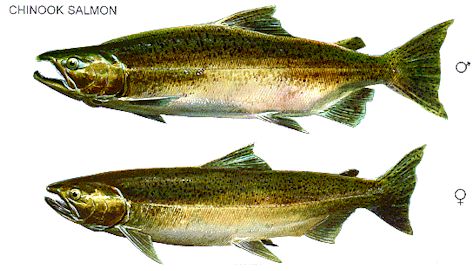
﹛
Coho Salmon (also known as
blueback and silver)
Fishing coho salmon in marine
phase
Coho have white gums, black
tongues and a few spots on the
upper portion of their bodies
and silver-coloured tails. They
have a wide tail base. Bright
silver with a metallic blue
dorsal surface. Coho usually
live for three years and grow
rapidly in their final year.
They weigh between 1.3 kg and 14
kg. In the Strait of Georgia
from April to early June, small
coho passing from the grilse
stage to maturity are called
bluebacks.
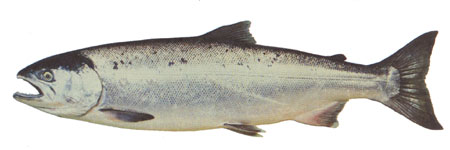
Fishing coho salmon in
freshwater phase
Fresh run coho are very similar
in appearance to salt water fish
- bright silver with a metallic
blue dorsal surface, and a wide
tail base with a few spots on
the upper portion of their
silver-coloured tails. As coho
mature, the males become reddish
on the sides, and green on the
back and head, often dark on
belly. Females are less strongly
coloured.
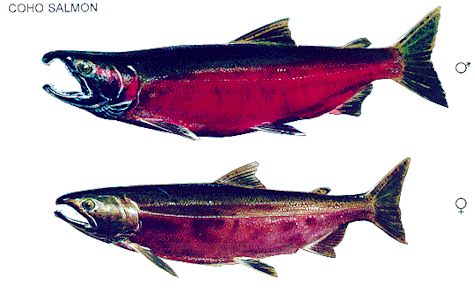
Sockeye Salmon (also known as
red salmon)
Fishing sockeye salmon in
marine phase
The
sockeye is almost toothless,
with numerous long gill rakers
and prominent, glassy eyes. The
slimmest and most streamlined of
the Pacific species, the
silver-blue sockeye lives from
four to five years. It usually
weighs between 2.2 kg and 3.1 kg
but can reach 6.3 kg. Young
sockeye remain in fresh-water
nursery lakes a year or more
before migrating to the sea.
Each sockeye salmon you keep
must be at least 30 cm long.

Fishing sockeye salmon in
freshwater phase
Maturing sockeye have a
distinctive silvery-purplish
tinge. As he becomes more
mature, the male acquires a pale
green head, dark hooked jaws,
humped back and bright red body
with red fins. The female is
generally the same with green
and yellow blotches on the body,
although the colour is less
pronounced and she does not
develop a hump or hooked jaw. In
most runs mature fish are bright
scarlet.

Pink Salmon (also known as
humpy)
Fishing pink salmon in marine
phase
Pink salmon have tiny scales and
a tail heavily marked with large
oval spots. Unlike the other
salmon species, the tail of a
pink has no silver in it. In the
sea, pinks have silver bodies
with spotted backs. They are the
smallest of the Pacific salmon,
usually weighing about 2.2 kg,
but occasionally reaching 5.5
kg. They are more abundant in
northern waters in even-numbered
years and in southern waters in
odd-numbered years. Pinks live
only two years.
Each pink salmon you keep must
be at least 30 cm long.

Fishing pink salmon in
freshwater phase
Mature males are yellowish gray
on the sides of their body,
blotched with brown, and dark
along back. Females are olive
green on the sides of their body
with dusky stripes. Both males
and females appear dirty white
below the lateral line, and
their tails have large oval
spots.
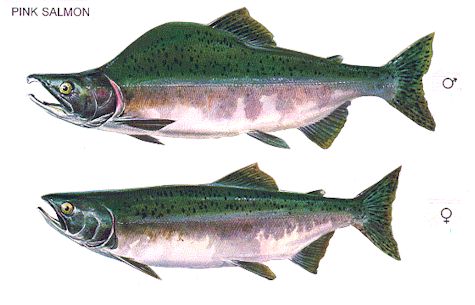
﹛
Chum Salmon (also known as dog
salmon)
Fishing chum salmon in
marine phase
A
white tip on the anal fin
usually identifies a chum
salmon. Resembling sockeye, but
larger, chum have silvery sides
and faint grid-like bars as they
near spawning streams. The tail
base is narrow and there is
silver in the tail. They live
three to five years and weigh
about 4.5 kg to 6.5 kg, but they
have been known to reach as much
as 15 kg.
Each chum salmon you keep must
be at least 30 cm long.

Fishing chum salmon in
freshwater phase
Maturing chum in freshwater show
reddish purple streaks or bars
and large pale blotches on a
pale background, and white on
the tips of pelvic and anal
fins. They have a greenish tinge
on their dorsal surface (back),
and no dark spots on caudal fin.
﹛
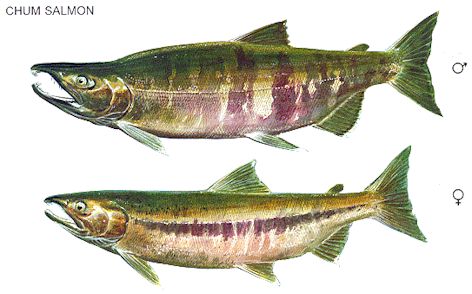
Fishing Trout
Trout includes steelhead, dolly
varden, cutthroat trout, brown
trout and bull trout.
Wild trout are those with an
adipose fin. Hatchery trout are
those with a healed scar in
place of the adipose fin.
Steelhead

The
fork length of a steelhead is 50
cm or more. They do not have
teeth in the throat at the back
of the
tongue.
Dolly Varden

These fish have small heads, and
oval snake-like bodies.
Cutthroat

This trout species has a large
mouth that extends well past the
eye, and teeth in the throat at
the back of the tongue. They
also have a lot of spots from
front to back.
South of a line due west from
Cape Caution
-
wild trout: catch and
release only.
-
hatchery trout: 2, none of
which may be less than 30
cm.
North of a line due west from
Cape Caution
-
hatchery and wild trout: 2,
only one of which may be
greater than 50 cm.
None may be less than 30 cm.
Exotic Alert: Atlantic Salmon in
B.C.
These fish are raised
commercially in pens in the
marine waters of B.C. and
Washington State. They are
distinguished from the Pacific
salmon species by 2 to 3 large
black spots on the gill cover,
and cross-hatched spots along
their body, above the lateral
line. They have large scales and
the tail fin is usually
unspotted, and some may have
eroded tails and/or dorsal fins.
Federal and provincial
biologists are interested in
verifying these Atlantic salmon
recoveries. Please note the date
and location of the catch, keep
the whole fish cool (do not
clean) and freeze it, if
possible, to prevent
deterioration of the tissues.
Contact the Atlantic Salmon
Watch Program :
1-800-811-6010.

Atlantic salmon can be
identified by:
-
8-11 anal fin rays (Pacific
salmon have 11-13 rays)
-
very noticeable, large,
black spots on the gill
cover (not common on native
salmon)
-
may have very noticeably
eroded or worn fins from
containment in net-pens
Angling Finfish
Spiny Dogfish

Spiny dogfish are mediumsized sharks with dark
gray or brown on the back and pale gray or white
on the belly; small dogfish have irregular white
spots on their back or sides. Average length is
between 75 and 105 cm, however large females can
be 160 cm and 10 kg. Both dorsal fins are
preceded by spines. Spiny dogfish live 25 to 30
years.
Due to relatively
high levels of mercury in the tissues of large
(and older) dogfish, it is recommended you eat
only those fish measuring less than 60 cm.
The daily limit is 20.
Eulachon
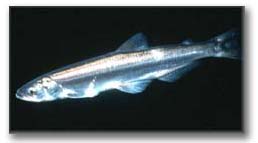
Eulachon, also
known as oolakan and candlefish, are small (20
to 25 cm) fish found from Alaska to California.
They are distinguished from other smelt by the
presence of common centre rings, running
parallel to each other, on the gill plate and
having the pelvic fins in front of the dorsal
fin.
When fishing by
means of a gillnet for eulachon or smelt, the
net cannot exceed 7.5 m in length and the mesh
size must be greater than 25 mm, but less than
50 mm. Check
current limits.
Flatfish (Flounder
& Sole)
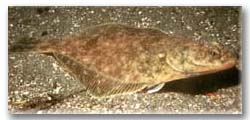 As larvae, flatfish resemble other fish in
having an eye on each side of their head.
However, the skull changes so that both eyes are
on one
As larvae, flatfish resemble other fish in
having an eye on each side of their head.
However, the skull changes so that both eyes are
on one
side of the head when they become young adults.
Both eyes are on the dark-coloured side of the
body, while the other side is eyeless and white.
Flatfish lie on the bottom with the dark-coloured
side up; some can change colour to match their
surrounding environment. Flatfish are oval or
diamond-shaped and have long dorsal and anal
fins. Most flatfish are ※dextral§, which means
the eyes and pigment are on their right side.
Sole/Flounder are
often misidentified as small halibut. They can
be found in waters up to 305 meters deep, and
may be fished using the same methods as for
halibut.
The combined daily limit for flounder and sole
is 8.
Greenling
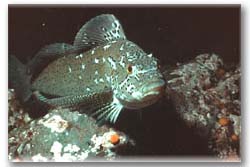
Greenlings are a
small, elongated fish with a long dorsal fin
split into long sections; one along the spine
area, and the other along the anal fin area.
Most are inshore species foraging in rocky
habitat or kelp and eelgrass beds. The two
species of interest to anglers are the kelp
greenling and the lingcod. Kelp greenlings reach
approximately 50 cm in length, and have small
mouths and five centre lines on each side. The
sexes are coloured differently: males are brown
with blue spots on the head and back, while
females are golden-brown with red spots.
Found in shallow,
sometimes intertidal areas with rocky or weedy
bottoms, greenling are easy to catch. They will
take almost any bait or lure. Although they are
often mistaken for lingcod, they do not reach
the same size. They may also share a similar
olive hue but tend to be much more brightly
coloured.
The daily limit is
3.
Halibut
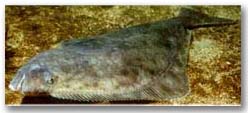
Halibut are the
largest flatfish species in B.C.
They are mottled olive-green, brown or black on
the dark coloured side and white on opposite.
The mouth is large with cone-shaped teeth and
the tail is broad and slightly forked. Females
are larger than males growing up to 267 cm in
length and weighing 226 kg. Male*s maximum size
is 140 cm and 56 kg.
No one may fish for
or retain halibut from January 1-31. Visit
halibut for more information.
Halibut Length-Net
Weight Table
|
Length |
Weight
dressed, head off, without ice & slime |
|
99 cm |
9.2 kg
(20.3 lbs) |
|
111 cm |
13.3 kg
(29.3 lbs) |
|
131 cm |
22.7 kg
(50.1 lbs) |
|
146 cm |
32.3 kg
(71.2 lbs) |
Herring

Pacific herring are silvery fish that form huge
schools. They are blue-green on the back and
silver below, with large, toothless mouths and
large eyes. Unlike shad or sardines, they have
no spots and they have large scales, unlike
smelts. Although they can reach lengths of 46
cm, most in B.C. are less than 25 cm.
This small fish is
the foremost baitfish in the Pacific Northwest,
utilized by recreational salmon anglers who
fillet it into "strip" for trolling and casting.
They may be caught by herring jig or rake, or by
using a dip or cast net. The daily limit for
herring is 20 kilograms.
Lingcod
Lingcod are large
predators with huge mouths armed with numerous
sharp teeth. They are brown with darker marks of
different colours, spots or shades on the back
and sides. Female lingcod grow to 150 cm,
although males rarely exceed 100 cm.
Biological
assessments have indicated that lingcod stocks
in the Strait of Georgia waters between
Vancouver Island and the mainland are severely
depressed and require protection if the stocks
are to rebuild.
In those areas where lingcod can be retained,
record your catch immediately on your licence.

There is a minimum size limit of 65 cm in Areas
11, 12 and 20 to 27. The length of a lingcod
means the distance measured along the body from
the tip of the nose to the tip of the tail. The
minimum size limit for a lingcod with the head
removed is 53 cm, measured along the shortest
length of the body to the tip of the tail. The
pectoral fins should remain attached.
See
table for limits. Note: Meat can
sometimes have a green tinge to it, which turns
white when it is cooked.
Mackerel
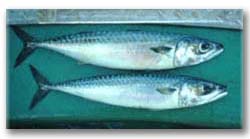
Two species are commonly referred to as
mackerel in B.C. One is the Chub or Pacific
mackerel which is a streamlined fish with two
dorsal fins and a series of five small finlets
between the second dorsal and tail. They have
blue-green backs with wavy irregular vertical
lines; can reach more than 60 cm in size,
although most are around 45 cm. The other
species is Jack mackerel which is similar in
appearance except that the second dorsal fin is
long with only a single finlet following. These
fish are blue-green above and silvery below with
a series of large scales along the lateral line.
They are generally larger than Chub mackerel,
reaching about 80 cm.
Mackerel are from the tuna family and are
frequently encountered off the west coast of
Vancouver Island during years when warm waters
from the El Niño current are prevalent. They are
rarely found inside the Strait of Georgia.
The daily limit for mackerel is 100.
Rockfish
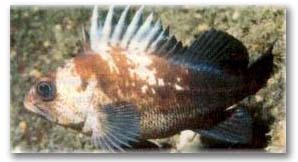
Rockfish are bass-like in appearance, with
large mouths and eyes, spines on the head and
gill plates, and prominent fins. Colour varies
between species with shallow water rockfish
generally having dark colours (green, brown or
black) and deep water species usually orange or
red. There are 35 species of rockfish known from
British Columbia. Depending on the species,
rockfish can range from 18 cm in length up to
120 cm.
Inshore rockfish need your help. Catch
monitoring and research programs have indicated
inshore rockfish stocks in the Strait of Georgia
are at very low levels of abundance. Rockfish
are very slow growing and do not reproduce until
they are quite old, from 7 to 20 years,
depending on the species. They also live for a
long time; the maximum age for yelloweye
rockfish is 118 years and 95 years for quillback
rockfish.
Unlike salmon, rockfish rarely survive after
being caught, therefore one way to ensure their
survival is to avoid catching them. Another way
is to fish away from rocky reef areas.
DFO has initiated a rockfish recovery
strategy, which includes Rockfish Conservation
Areas (RCAs). RCAs have been established to help
protect rockfish by restricting fishing activity
in and around the waters where these fish live.
Permitted sport fishing activity in an RCA
includes:
- hand picking or diving for invertebrates
- fishing for crab or prawn by trap
- fishing for smelt by gillnet
﹛
Sardine
Pacific Sardines, commonly called pilchards,
are a small migratory fish related to herring
and shad. Sardines migrate to B.C. from
California during the late summer and remain
until the fall when they migrate back to
California to spawn. They can be recognized by a
row of black spots on the sides of the body
under the scales. Sardines are most frequently
encountered off the west coast of Vancouver
Island during years when warm El Niño waters are
prevalent. They are rarely found inside the
Strait of Georgia.
The daily limit is 100.
Smelt
Smelt are relatively small, silvery fish.
They move in large schools along the coastline
during migration to their spawning grounds on
beaches and in estuaries. Smelt usually reach
only 15 cm.
Smelt fishing is closed from June 15 to
August 15 inclusive, in waters of the Lower
Mainland east of a line from Reception Point on
the Sechelt Peninsula, to Thrasher Rock Light
and to the most westerly point of the
International Boundary in the Strait of Georgia.
These same waters are also closed to sport
fishing for smelt from 8 a.m. Monday to 8 a.m.
Thursday at all other times of the year.
 When
fishing for smelt or eulachon by means of a
gillnet, the net cannot exceed 7.5 m in length
and the mesh size must be greater than 25 mm,
but less than 50 mm. When
fishing for smelt or eulachon by means of a
gillnet, the net cannot exceed 7.5 m in length
and the mesh size must be greater than 25 mm,
but less than 50 mm.
A floating buoy clearly marked with the name of
the owner must be attached to each end of the
net. The daily limit is 100.
Stanley Park smelt fishers
Fishing for smelt in Stanley Park requires
special consideration of other users of the
seawall. Dip net fishers must ensure that they
do not pull their net poles back into the paths
of passing pedestrians or cyclists. Gill-netters
should pick their nets in such a fashion as to
avoid leaving scales and parts of the fish on
the path, making it slippery for others. In
addition, gillnets must not block or impede
traffic on the seawall. Garbage and waste must
be placed in Parks Board garbage cans, and
public washrooms available in the park must be
used at all times.
Pacific Spirit Park smelt fishers
Pacific Spirit Park includes all beaches from
the Fraser River's north arm around Point Grey
to Acadia Beach, near Spanish Banks Beach. Park
hours from the start of Daylight Saving Time to
Labour Day - 8 am to 9 pm. All other days - 8 am
to dusk. Fishers are not allowed to access the
park outside of these hours. Liquor, camping and
fires are not permitted in the park.
Please observe the rules.
Sturgeon

Sturgeon are made up of a tough, elastic,
fibrous connective tissue (cartilage), and can
grow to six metres long and weigh over 600 kg.
Their elongate body usually ranges from greenish
grey on the back to light grey or white on the
belly. Instead of scales, their bodies have five
rows large armour-like plates know as scutes.
They have long noses and projecting mouths,
located on the lower part of the head,
accompanied by four fleshy whiskers known as
barbels. There are two species of sturgeon in
B.C.; both white and green sturgeon occur
inshore and in large river systems. Only the
smaller green sturgeon can be found further
offshore.
In all tidal waters there is no retention
of sturgeon.
In the tidal waters of the Fraser River,
barbless hooks are required.
If fishing for sturgeon, an angler may only
use one line, and must release any sturgeon
caught. The B.C. government has also taken
action to protect sturgeon in the non-tidal
portion of the Fraser River, and have a tagging
program in place. See the
provincial regulations.
Surfperch
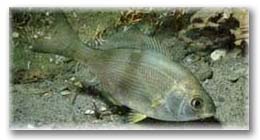
Surfperch have compressed deep bodies with
large eyes and relatively small mouths. The
striped seaperch sports bright blue and gold
stripes; the pile perch is silvery with black
vertical bars; and the shiner perch is silver
with vertical gold bars. The shiner perch is the
smallest surfperch, reaching 20 mm in length,
while the pile perch is the largest, growing up
to 45 cm in length.
Perch
give birth to low numbers of live young and may
be subject to local population depletion in
areas of high fishing pressure. It is requested
that anglers release all perch, that will not be
retained, with the least possible harm. The
combined daily limit of perch is 8.
﹛
Angling Shellfish
Shellfish refers
to aquatic
invertebrate
(without a
backbone)
animals.
Shellfish such
as crabs, clams
and sea urchins
have a hard
outer shell,
however some
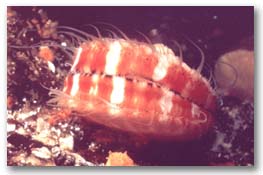 species
such as squid,
sea cucumbers,
and octopus the
shells are
hidden or
absent. species
such as squid,
sea cucumbers,
and octopus the
shells are
hidden or
absent.
Bivalve molluscs
are shellfish
with two shells,
such
as clams,
oysters,
scallops and
cockles.
ABALONE
 Northern
abalone have thin, oval shells
with an irregular reddish or
greenish upper surface,
sometimes marked with blue or
white, and often overgrown with
encrusting organisms. The
interior is iridescent white
with a faint pink and green
sheen. There is a series of
three to six raised holes
allowing water currents to pass
over the abalone*s gills. Northern
abalone have thin, oval shells
with an irregular reddish or
greenish upper surface,
sometimes marked with blue or
white, and often overgrown with
encrusting organisms. The
interior is iridescent white
with a faint pink and green
sheen. There is a series of
three to six raised holes
allowing water currents to pass
over the abalone*s gills.
Due
to serious conservation
concerns, the entire coast of
B.C. is CLOSED to harvest
of abalone. Northern (or pinto)
abalone are protected in Canada
under the federal
Species at Risk Act (SARA).
Illegal harvest is considered to
be the most significant threat
to northern abalone recovery.
Help stop the illegal harvest
and sale of abalone - report
violations to 1-800-465-4336.
For further information, visit
the
abalone
website.
CLAMS
The five clam species of primary
interest to fishers are Manila,
native littleneck, butter, razor
and varnish clams. Manila and
littleneck clams are similar in
appearance, both possessing
lines that go up and across on
the outer surface of their
shells. Manilas are elongated in
profile and purple on the inside
of the shells, while littlenecks
are round with white on the
inside of the shells. Butter
clams are large and thick
shelled, with only common centre
lines on the shells. Both
varnish and razor clams have a
shiny brown covering on the
outer surface of the shells.
Varnish clams are round in
profile with a large external
ligament at the hinge, while
razor clams are oblong in shape.
Manila, littleneck, butter and
varnish clams live in gravel and
sand beaches in protected bays.
Razor clams live on wave-swept
sand beaches open to the Pacific
Ocean.
The Lower Mainland area is
closed to clam harvesting.
The most effective method for
digging manila clams is an
ordinary short-tined garden
rake. On beaches with extensive
populations of littleneck clams,
diggers use long-tined rakes.
The butter clams, lying further
below the surface and further
down the beach, are usually dug
with a garden-type, long-handled
potato fork. Razor clams are dug
individually with a
short-handled, thin-bladed
shovel. Harvesters are
encouraged to fill in holes to
reduce predation on exposed
juvenile clams.
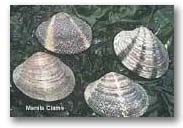 
Manila Clams
Butter Clam
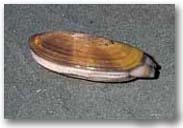 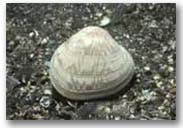
Razor Clam
LittleNeck Clam

Varnish Clam
Immediately prior to harvesting, check for
shellfish closures with the nearest DFO
office, or by calling 604-666-2828, or visit
the
sewage and biotoxin contamination closures
website for PSP and other shellfish
closures.
Daily limits vary according to area and
species. Check the
shellfish table for limits.
CRABS
Crabs have three to
four pairs of walking legs and a pair of claws
that are used for feeding and defence. Female
crabs carry egg clusters on the underside of
their bodies.
Crabs shed their
old shell in order to grow, increasing in size
before the new shell hardens, in a process
called molting. Although there are nearly 100
species of crab in B.C., the two species of most
interest to fishers are Dungeness crab and Red
Rock crab. Dungeness crabs are graybrown on the
back and yellow underneath, and their claws have
white tips. Red Rock crabs are brick red above
and white below, and their claws have black
tips.
Dungeness crab must
be at least 165 mm in width. Redrock crab must
measure at least 115 mm. Undersized crab must be
returned to the water immediately. A crab is
measured in a straight line through the widest
part of the carapace, or shell, from outside the
points. Harvesters are advised to measure crabs
using a caliper device.
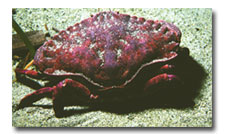 
Redrock Crab
Pacific (Dungeness) Crab
For information on
harvesting crabs, visit
Crabs and Crabbing.
MUSSELS
Mussels have
bluish-black shells curved in a distinctive ※D§
shape, like a flattened teardrop. The inside of
the shell is pearly violet or white. Projecting
from between the shells on the flat side is a
bundle of tough, brown byssal threads, which are
used to anchor the mussel to hard surfaces.
Inshore waters support the native blue mussel,
which can reach nine cm in length. Wave-swept
rocky shores have beds of the larger California
mussel, which grows to 25 cm in length. The Blue
mussel has a smooth outer shell surface with
growth rings, while the California mussel has
raised radial ribs.
Immediately prior
to harvesting, check for shellfish closures with
the nearest DFO office, or by calling
604-666-2828, or visit the
sewage and biotoxin contamination closures
website for PSP and other shellfish closures.
Check the
shellfish table for limits. In the Pacific
Rim National Park the combined daily limit for
mussels is 12.
OCTOPUS
 The
octopus has eight tentacles that sometimes
stretch 4.8 m across in a 45 kg specimen. The
octopus is a mollusc that is related to the
squid, oyster, clam and snail. The giant Pacific
octopus is the major species on the west coast
and also the world's largest. It is illegal to
use jigs, gaffs, spears, rakes or any other
sharp-pointed instrument to take octopus. It is
recommended that harvesters use a very sharp
knife to kill Octopus quickly. The
octopus has eight tentacles that sometimes
stretch 4.8 m across in a 45 kg specimen. The
octopus is a mollusc that is related to the
squid, oyster, clam and snail. The giant Pacific
octopus is the major species on the west coast
and also the world's largest. It is illegal to
use jigs, gaffs, spears, rakes or any other
sharp-pointed instrument to take octopus. It is
recommended that harvesters use a very sharp
knife to kill Octopus quickly.
Daily limit is 1.
﹛
OYSTERS
Pacific oysters are
large shellfish that are the primary species
cultured in southern B.C. Their shells are thick
with a rough sculptured appearance. Shell colour
varies: the outside is a combination of browns,
greens and grays, often with sharp purple
fluting near the edges. The interior is white
and satin smooth. The two shells of the oyster
are held together by a ligament at the hinge and
a large adductor muscle.
The North Coast
(Areas 1-11) is closed to the harvest of oysters
due to PSP concerns.
The Lower Mainland
area is closed to oyster harvesting.
 Immediately
prior to harvesting, check for shellfish
closures with the nearest DFO office, or by
calling 604-666-2828, or visit the
sewage and biotoxin contamination closures
website for PSP and other shellfish closures. Immediately
prior to harvesting, check for shellfish
closures with the nearest DFO office, or by
calling 604-666-2828, or visit the
sewage and biotoxin contamination closures
website for PSP and other shellfish closures.
Return oyster
shells to the beach, preferably where you
collected them. Oyster larvae survive at a much
better rate if they settle on the old shells.
NOTE: Permission is
required to harvest oysters from marked oyster
farms.
Check the
shellfish table for limits.
Olympia Oysters
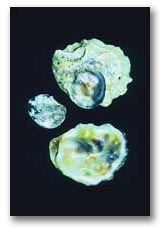 The
Olympia oyster (Ostrea conchaphila) is the only
native oyster along the west coast of Canada. It
is a small oyster species, with a maximum
reported size of 9 cm, although most individuals
are less than 5 cm. Large clusters of Olympia
oysters once existed in the Strait of Georgia,
however only small groupings have survived. They
exist in a few sites on the west coast of
Vancouver Island but little information exists
on populations in Johnstone Strait or the
Central and North Coasts. Given the history of
poor resilience to directed harvests and the
relatively limited number of sites where
Olympias occur, recreational fishers are asked
to not disturb these oysters. The
Olympia oyster (Ostrea conchaphila) is the only
native oyster along the west coast of Canada. It
is a small oyster species, with a maximum
reported size of 9 cm, although most individuals
are less than 5 cm. Large clusters of Olympia
oysters once existed in the Strait of Georgia,
however only small groupings have survived. They
exist in a few sites on the west coast of
Vancouver Island but little information exists
on populations in Johnstone Strait or the
Central and North Coasts. Given the history of
poor resilience to directed harvests and the
relatively limited number of sites where
Olympias occur, recreational fishers are asked
to not disturb these oysters.
Fishing
restrictions may be introduced in the future.
﹛
SCALLOPS
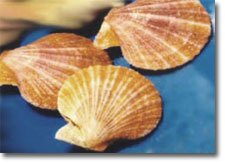
Of the 10 species
of scallop known from B.C., only four are of
interest to fishers. Spiny and pink scallops are
relatively small (less than 10 cm) and reddish
in colour. Weathervane scallops are large (15 to
20 cm) with brown upper shells and whitish lower
shells. Rock scallops are large (up to at least
20 cm) with thick, rough shells often overgrown
with encrusting organisms. Spiny, pink and
weathervane scallops are swimming scallops,
while adult rock scallops attach themselves to
objects.The North Coast (Areas 1-11) is closed
to the harvest of rock, pink, spiny and
weathervane scallops due to PSP concerns.
Immediately prior
to harvesting, check for shellfish closures with
the nearest DFO office, or by calling
604-666-2828, or visit the
sewage and biotoxin contamination closures
website for PSP and other shellfish closures.
Check the
shellfish table for limits.
For more
information about
scallops.
SEA CUCUMBERS
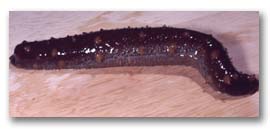
The daily limit for sea cucumbers is 12.
For more
information on
sea cucumbers.
SEA URCHINS

The daily limit for sea urchins is 12.
For more
information on
sea urchins.
SHRIMP & PRAWNS
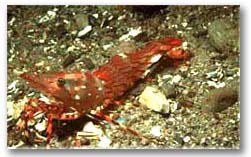 Shrimp
have two body sections protected by a hard outer
covering called a carapace. They sport antennae,
eyes, mouthparts, and feeding and walking legs.
The muscular abdomen extends behind the carapace
and has swimming legs and a fanlike tail. Most
shrimp live three years: one as a juvenile, one
as a male and one as a female. Five of the 85
species of shrimp found in B.C. are of interest
to fishers: coonstripe, humpback, smooth and
spiny pink shrimp, and prawns. Coonstripe shrimp
are red-brown with irregular brown and white
oblique lines on the carapace and abdomen.
Humpback shrimp are red-tan with dark red and
bright white markings.Pink shrimp are uniform
translucent red. Prawns, the largest shrimp in
B.C. (25 cm in length), are red with white
horizontal bars on the carapace and at least two
pairs of white spots on the abdomen. Coonstripe
shrimp live in shallow water on or near pilings
and floats; humpback shrimp on soft or hard
bottoms; pink shrimp on soft bottom; and prawns
in rocky areas. Shrimp
have two body sections protected by a hard outer
covering called a carapace. They sport antennae,
eyes, mouthparts, and feeding and walking legs.
The muscular abdomen extends behind the carapace
and has swimming legs and a fanlike tail. Most
shrimp live three years: one as a juvenile, one
as a male and one as a female. Five of the 85
species of shrimp found in B.C. are of interest
to fishers: coonstripe, humpback, smooth and
spiny pink shrimp, and prawns. Coonstripe shrimp
are red-brown with irregular brown and white
oblique lines on the carapace and abdomen.
Humpback shrimp are red-tan with dark red and
bright white markings.Pink shrimp are uniform
translucent red. Prawns, the largest shrimp in
B.C. (25 cm in length), are red with white
horizontal bars on the carapace and at least two
pairs of white spots on the abdomen. Coonstripe
shrimp live in shallow water on or near pilings
and floats; humpback shrimp on soft or hard
bottoms; pink shrimp on soft bottom; and prawns
in rocky areas.
The daily limit for
shrimp is 200 and the possession limit is
400.
For conservation
purposes, prawns carrying eggs under their tail
should be released.
Check the
shellfish table for limits.
Visit
shrimp and prawns for further information on
harvesting and gear.
SQUID
Squid are swimming
soft-bodied animals characterized by a muscular
tube called the mantle. The mantle has fins at
the narrow end, contains the internal organs and
is open at the end supporting the head, arms and
tentacles.

Squid have large
eyes, 10 arms and two feeding tentacles that
have suckers and sometimes hooks on pads at the
ends. They swim slowly using their fins and
force water from the mantle through a siphon for
burst of greater speed. Depending on activity
level, squid change colour rapidly. Three
species are of interest to B.C. fishers: opal
squid, neon flying squid and Humboldt squid.
Opal squid are relatively small (up to 13 cm in
B.C.) and are pale lavender in colour. They are
found in inshore waters, most noticeably when
they gather in large schools to spawn in shallow
water. Neon flying squid are relatively large
(up to 100 cm and 5 kg). They are mauve on the
upper surface and silvery or gold below; the
tentacle sucker rings are distinctivewith four
large teeth and numerous smaller teeth in
between. Humboldt squid are very large (up to
200 cm and 45 kg) and are brown or red in colour.
Please Note:
Make
sure you know what the size and catch limits are
for the species that you intend to harvest.
Provincial Parks,
National Parks, and ecological reserves, may
have species limits or restrictions. Be sure to
check with the local DFO office or Park Office
prior to harvesting.
AQUATIC INVASIVE
SPECIES
Plants and animals
which do not occur naturally in an area are
referred to as aquatic invasive species (AIS).
In marine waters, some AIS have been introduced
for commercial reasons. Pacific oysters and
Manila clams are prime examples of such species
on the West Coast. Other, not so welcome exotic
species, may arrive in the ballast water of
foreign ships, on the propeller or hull of
recreational boats, through pet stores, research
institutions, or with live imported bait or
seafood.
AIS can be
detrimental to our native populations of plants
and animals. Your help in documenting aquatic
invasive species in our waters is needed.
European Green Crab
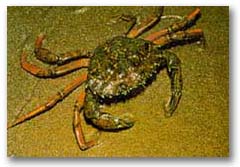
The European green
Crab (Carcinus maenas), has arrived in B.C.
waters. Surveys conducted in 2006 found green
crab in Barkely Sound, Clayquot Sound, Nootka
Sound and Esperanza Inlet. Green crab may pose a
serious threat to estuarine and marine
ecosystems on the West Coast of North America as
they are voracious predators feeding on a
variety of intertidal plants and animals,
including oysters, mussels, clams and juvenile
crabs.
How to identify:
five lateral carapace spines; carapace width up
to 10 cm;
three rounded lobes between eyes; rear legs are
flattened for swimming;
colour varies from yellow/green to reddish/brown
for live animals and
&washed or baked* red for moults.
Tunicate Species
 Several
exotic tunicate (sea squirt) species have
invaded Canadian waters. At least six of these
species have been reported in B.C. and most are
the focus of ongoing monitoring and research
projects. Several
exotic tunicate (sea squirt) species have
invaded Canadian waters. At least six of these
species have been reported in B.C. and most are
the focus of ongoing monitoring and research
projects.
 Those
of concern include individual or solitary
tunicates (clubbed tunicate and vase tunicate)
and grouped or colonial tunicates (golden star
tunicate, violet tunicate). Tunicates generally
are found on a variety of submerged structures
(e.g.: docks, buoys, ropes, anchors, pilings,
boat hulls, etc.). Many of the exotic tunicate
species have the ability to overgrow native
species affecting community structure and
dynamics. Those
of concern include individual or solitary
tunicates (clubbed tunicate and vase tunicate)
and grouped or colonial tunicates (golden star
tunicate, violet tunicate). Tunicates generally
are found on a variety of submerged structures
(e.g.: docks, buoys, ropes, anchors, pilings,
boat hulls, etc.). Many of the exotic tunicate
species have the ability to overgrow native
species affecting community structure and
dynamics.
How to identify:
colonial tunicates grow in dense colonies of
individual organisms (zooids) with a gelatinous
texture. Solitary tunicates can be distinguished
by the arrangement of the zooids.
Mitten Crab
Mitten crabs,
originally from Asia, are another exotic species
to North America. This crab poses a serious
threat to freshwater and tidal water ecosystems,
and was first discovered on the west coast of
California in 1992. There is reason to believe
that they could migrate into B.C. waters.
Mitten crabs live
in freshwater but migrate to tidal water to
reproduce (they are the only freshwater crab in
North America). They can eat salmon, trout and
sturgeon eggs and may threaten successful
spawning of these species. They have also been
known to damage fish habitat due to erosion of
river banks.
These crabs are
easily identifiable by two hairy, equal-sized
claws. They have a notch between the eyes and
may be up to 100 mm wide. The colour of Mitten
crabs varies from light brown to olive green.
Zebra Mussels
Zebra mussels, a
freshwater mollusc, are an introduced or exotic
species to Canada. They were introduced to the
Great Lakes System in 1988 and have spread
rapidly to inland lake systems in Ontario,
likely aided by recreational boating traffic.
Zebra mussels are
invisible to the naked eye in their early life
stages (called veliger), when they can be
transferred unknowingly in pipes, live wells,
bilge water and baitfish buckets. They are
generally found in shallow (6-30 feet),
algae-rich water.
Where Zebra mussels
have colonized, often in large clusters, they
have clogged municipal and industrial water
intake lines, covered boat hulls, fouled
beaches, killed native clams and disrupted lake
ecosystems.
At three weeks,
they begin to form hard shells and will resemble
loose gravel or silt. Even at this early stage,
Zebra mussels can attach to hard objects by
"holdfasts" 每strong, tough, byssal threads.
Angling Lake fish
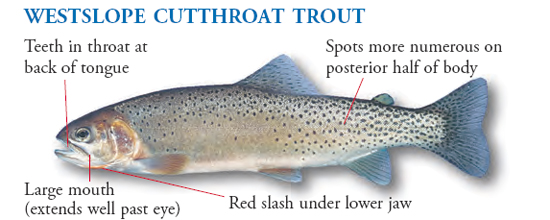


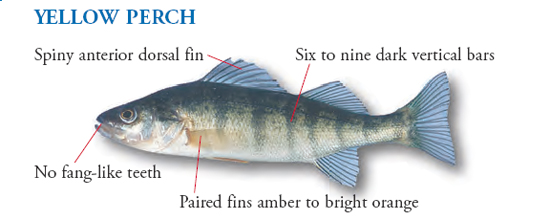


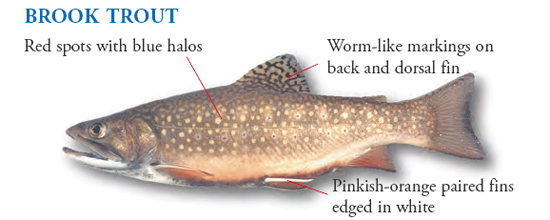
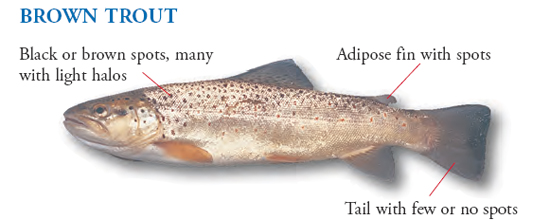
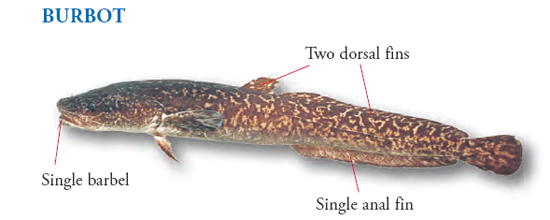
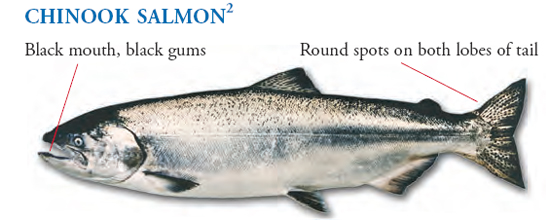

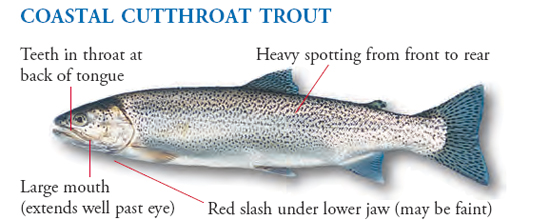
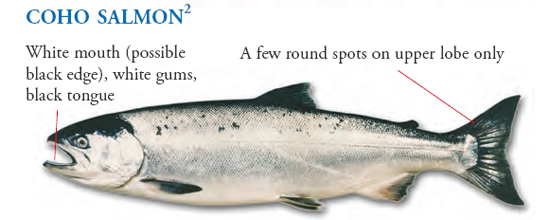
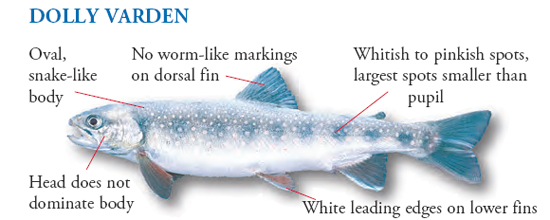
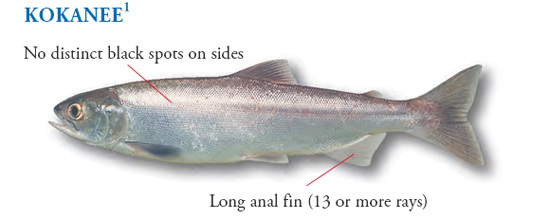



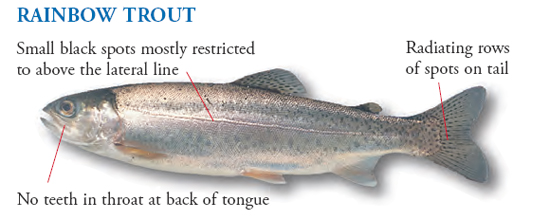


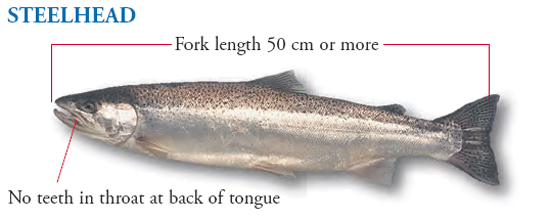

﹛ |
Angling
Licenses
﹛
Fishing Regulations
request each angler must have his fishing license with him all
the time when he goes fishing.
﹛
Tidal Water (For Finfish, Shellfish)
﹛
Canadians: Basic+Salmon Stamp
-
Annual: Adult $22.47, Senior 11.77, Child $0, Salmon Stamp
$6.42
-
5-Day Angling: $16.08, Salmon Stamp $6.42
-
3-Day Angling: $11.55, Salmon Stamp $6.42
-
1-Day Angling: $5.51, Salmon Stamp $6.42
Foreigners: Basic+Salmon Stamp
-
Annual: Adult $106.05, Senior 106.05, Child $0, Salmon Stamp
$6.42
-
5-Day Angling: $32.55, Salmon Stamp $6.42
-
3-Day Angling: $19.95, Salmon Stamp $6.42
-
1-Day Angling: $7.35, Salmon Stamp $6.42
Note: Child (Under 16 years of age), Senior (Over 65 years of
age), Adult (Between 16 and 64). If the child has his/her own
license, he/she must be capable of fishing independently. If no,
the parents or guardians must have and the quota will count to
that of parents or guardians.
﹛
Fresh Water
﹛
Resident: Basic+Salmon+Steelhead+Rainbow Trout+Classified Water
Stamp
-
Annual: Adult $36, Disabled $1, Senior $1, Child No, Salmon
$15, Steelhead $25, Rainbow Trout $10, Classified Water $15
-
8-Day Angling: $20, Salmon $15, Steelhead $25, Rainbow Trout
$10, Classified Water $15
-
1-Day Angling: $10, SSalmon $15, Steelhead $25, Rainbow
Trout $10, Classified Water $15
Non-Resident: Basic+Salmon+Steelhead+Rainbow Trout+Classified
Water Stamp
-
Annual: Adult $55, Disabled $55, Senior $55, Child No,
Salmon $15, Steelhead $25, Rainbow Trout $10, Classified
Water $15
-
8-Day Angling: $36, Disabled $36, Senior $36, Child No,
Salmon $15, Steelhead $25, Rainbow Trout $10, Classified
Water $15
-
1-Day Angling: $20, Disabled $20, Senior $20, Child No,
Salmon $15, Steelhead $25, Rainbow Trout $10, Classified
Water $15
Foreigner: Basic+Salmon+Steelhead+Rainbow Trout+Classified Water
Stamp
-
Annual: Adult $80, Disabled $80, Senior $80, Child No,
Salmon $15, Steelhead $25, Rainbow Trout $10, Classified
Water $15
-
8-Day Angling: $50, Disabled $50 Senior $50, Child No,
Salmon $15, Steelhead $25, Rainbow Trout $10, Classified
Water $15
-
1-Day Angling: $20, Disabled $20, Senior $20, Child No,
Salmon $15, Steelhead $25, Rainbow Trout $10, Classified
Water $15
Note: Child (Under 16 years of age), Senior (Over 65 years of
age), Adult (Between 16 and 64). For children, there is no
special regulations like those in tidal water.
|
|
﹛ |

|
|
Fishing Tour |

by Location
by species
|
|
Salmon |

|
|
Finfish |

|
|
Shellfish |

-
Abalone
-
Clams
-
Crabs
-
Mussels
-
Octopus
-
Oysters
-
Scallops
Sea Cucumbers
-
Sea Urchins
-
Shrimp & Prawns
-
Squid
-
Aquatic Invasive
Species
|
|
Lake fish |

-
Rainbow Trout
-
Steelhead
-
Cutthroat Trout
-
Brown Trout
-
Dolly Varden
-
Bull Trout
-
Lake Trout
-
Brook Trout
-
Lake Whitefish
-
Mountain Whitefish
-
Largemouth Bass
-
Smallmouth Bass
-
Kokanee
-
Arctic Grayling
-
BurbotLing)
-
White Sturgeon
-
Blask Crappie
-
Northern Pike
-
Goldeye
-
Inconnu
-
Crayfish
|
|
Back |

Half-Day Fishing Salmon Tour
-
Time: From August to November.
-
Place: Richmond, Fraser River, Vedder River, Chilliwack
River.
-
Fish: Chinook, Sockeye, Coho, Pink, Chum.
-
Tackle: Free rental of fishing rod, reel, line, swivel,
leader, weight, hook, float, wool, cockie, Spoon, not
including wader and others related to the water.
-
Requirement: Minimum 4 people, not including transportation,
license fees, accommodation.
One-Day Fishing Salmon Tour
-
Time: From August to November.
-
Place: Hope, Fraser River, Vedder River, Chilliwack River.
-
Fish: Chinook, Sockeye, Coho, Pink, Chum.
-
Tackle: Free rental of fishing rod, reel, line, swivel,
leader, weight, hook, float, wool, cockie, Spoon, not
including wader and others related to the water.
-
Requirement: Minimum 4 people, not including transportation,
license fees, accommodation.
Half-Day Fishing Trout Tour
-
Time: From May to August.
-
Place: Vancouver, North Vancouver, West Vancouver,
Coquitlam.
-
Fish: Trout.
-
Tackle: Free rental of fishing rod, reel, line, swivel,
leader, weight, hook, float, wool, cockie, Spoon, Powerbait,
not including wader and others related to the water.
-
Requirement: Minimum 4 people, not including transportation,
license fees, accommodation.
One-Day Fishing Trout Tour
-
Time: From May to August.
-
Place: Vancouver, North Vancouver, West Vancouver,
Coquitlam, Mission, Harrison.
-
Fish: Trout.
-
Tackle: Free rental of fishing rod, reel, line, swivel,
leader, weight, hook, float, wool, cockie, Spoon, Powerbait,
not including wader and others related to the water.
-
Requirement: Minimum 4 people, not including transportation,
license fees, accommodation.
Half-Day Fishing Sturgeon Tour
-
Time: From April to October.
-
Place: Richmond.
-
Fish: Sturgeon.
-
Tackle: Free rental of fishing rod, reel, line, swivel,
leader, weight, hook, bait, not including wader and others
related to the water.
-
Requirement: Minimum 4 people, not including transportation,
license fees, accommodation.
One-Day Fishing Sturgeon Tour
-
Time: From April to October.
-
Place: Richmond.
-
Fish: Sturgeon.
-
Tackle: Free rental of fishing rod, reel, line, swivel,
leader, weight, hook, bait, not including wader and others
related to the water.
-
Requirement: Minimum 4 people, not including transportation,
license fees, accommodation.
Half-Day Fishing Dogfish Tour
-
Time: From April to October.
-
Place: Vancouver, Delta.
-
Fish: Dogfish.
-
Tackle: Free rental of fishing rod, reel, line, swivel,
leader, weight, hook, bait, not including wader and others
related to the water.
-
Requirement: Minimum 4 people, not including transportation,
license fees, accommodation.
One-Day Fishing Dogfish Tour
-
Time: From April to October.
-
Place: Vancouver, Delta.
-
Fish: Dogfish.
-
Tackle: Free rental of fishing rod, reel, line, swivel,
leader, weight, hook, bait, not including wader and others
related to the water.
-
Requirement: Minimum 4 people, not including transportation,
license fees, accommodation.
Half-Day Fishing Whitefish Tour
-
Time: From April to October.
-
Place: Richmond, Delta.
-
Fish: Whitefish.
-
Tackle: Free rental of fishing rod, reel, line, swivel,
leader, weight, hook, bait, not including wader and others
related to the water.
-
Requirement: Minimum 4 people, not including transportation,
license fees, accommodation.
﹛ |
|
﹛ |